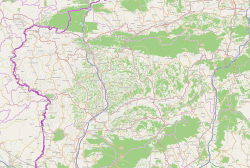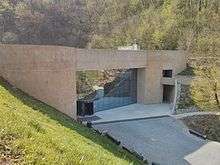Krapina
| Krapina | |||||
|---|---|---|---|---|---|
| Town | |||||
|
Top: Krapina Rectory; Bottom left: Town center; Bottom right: Chestnut tree alley | |||||
| |||||
 Krapina  Krapina Location of Krapina in Croatia | |||||
| Coordinates: HR 46°10′N 15°52′E / 46.16°N 15.87°ECoordinates: HR 46°10′N 15°52′E / 46.16°N 15.87°E | |||||
| Country |
| ||||
| County |
| ||||
| Government | |||||
| • Mayor | Zoran Gregurović (HDZ) | ||||
| Area | |||||
| • Town | 47.53 km2 (18.35 sq mi) | ||||
| Elevation | 203 m (666 ft) | ||||
| Population (2011)[1] | |||||
| • Town | 12,479 | ||||
| • Density | 260/km2 (680/sq mi) | ||||
| • Urban | 4,482 | ||||
| Time zone | Central European Time (UTC+1) | ||||
| Postal code | 49 000 | ||||
| Area code(s) | 049 | ||||
| Vehicle registration | KR | ||||
| Website | http://www.krapina.hr/ | ||||
Krapina (pronounced [krâpina][2]) is a town in northern Croatia and the administrative centre of Krapina-Zagorje County with a population of 4,482 (2011) and a total municipality population of 12,480 (2011).[1] Krapina is located in the hilly Zagorje region of Croatia, approximately 55 km (34 mi) away from both Zagreb and Varaždin.
Population
The following settlements comprise the Krapina municipality:[1]
- Bobovje, population 510
- Doliće, population 436
- Donja Šemnica, population 912
- Gornja Pačetina, population 404
- Krapina, population 4,471
- Lazi Krapinski, population 79
- Lepajci, population 391
- Mihaljekov Jarek, population 469
- Podgora Krapinska, population 565
- Polje Krapinsko, population 666
- Pretkovec, population 66
- Pristava Krapinska, population 214
- Strahinje, population 328
- Straža Krapinska, population 42
- Škarićevo, population 707
- Šušelj Brijeg, population 4
- Tkalci, population 432
- Trški Vrh, population 399
- Velika Ves, population 727
- Vidovec Krapinski, population 215
- Vidovec Petrovski, population 101
- Zagora, population 94
- Žutnica, population 248
History
Krapina has been known since 1193. It has always been a favorite site for castles and country houses of Croatian and Hungarian rulers.
In the late 19th and early 20th century, Krapina was a district capital in the Varaždin County of the Kingdom of Croatia-Slavonia.
In 1899, on a hill called Hušnjakovo near modern Krapina, the archaeologist and paleontologist Dragutin Gorjanović-Kramberger found over eight hundred fossil remains belonging to Neanderthals.
The half-cave in Krapina was soon listed among the world"s science localities as a rich fossil finding site, where the largest and richest collection of the Neanderthal man had ever been found. In the sandy deposits of the cave about nine hundred remains of fossilised human bones were found - the fossil remains belonged to several dozen different individuals, of different sex, from 2 to 40 years of age.
Culture

Krapina is a home to yearly Festival kajkavske popevke (The festival of kajkavian song) sung in the local Kajkavian dialect.[3]
At the site where the Neanderthals remains were discovered there is now a state-of-the-art Neanderthal museum which also includes an extensive segment on evolution, making it one of the most interesting evolutionary museums in Europe.[4] It is surrounded by a park with many statues of Neanderthals and their game, a bear, a moose and a beaver set in the actual locations. There is also a nearby municipality of Krapinske Toplice (Krapina spa) with numerous thermal springs and spa tourist infrastructure. Krapina is also the birthplace of the linguist and language reformer Ljudevit Gaj. His home is now a museum where visitors can learn about his life and work.
References
- 1 2 3 "Population by Age and Sex, by Settlements, 2011 Census: Krapina". Census of Population, Households and Dwellings 2011. Zagreb: Croatian Bureau of Statistics. December 2012.
- ↑ "Hrvatski jezični portal". Retrieved 25 August 2015.
- ↑ Official Website of Kajkavske popevke
- ↑ "Muzej krapinskih neanadertalaca". Mkn.mhz.hr. 2010-02-27. Retrieved 2013-03-26.
External links
| Wikimedia Commons has media related to Krapina. |
| Wikivoyage has a travel guide for Krapina. |

